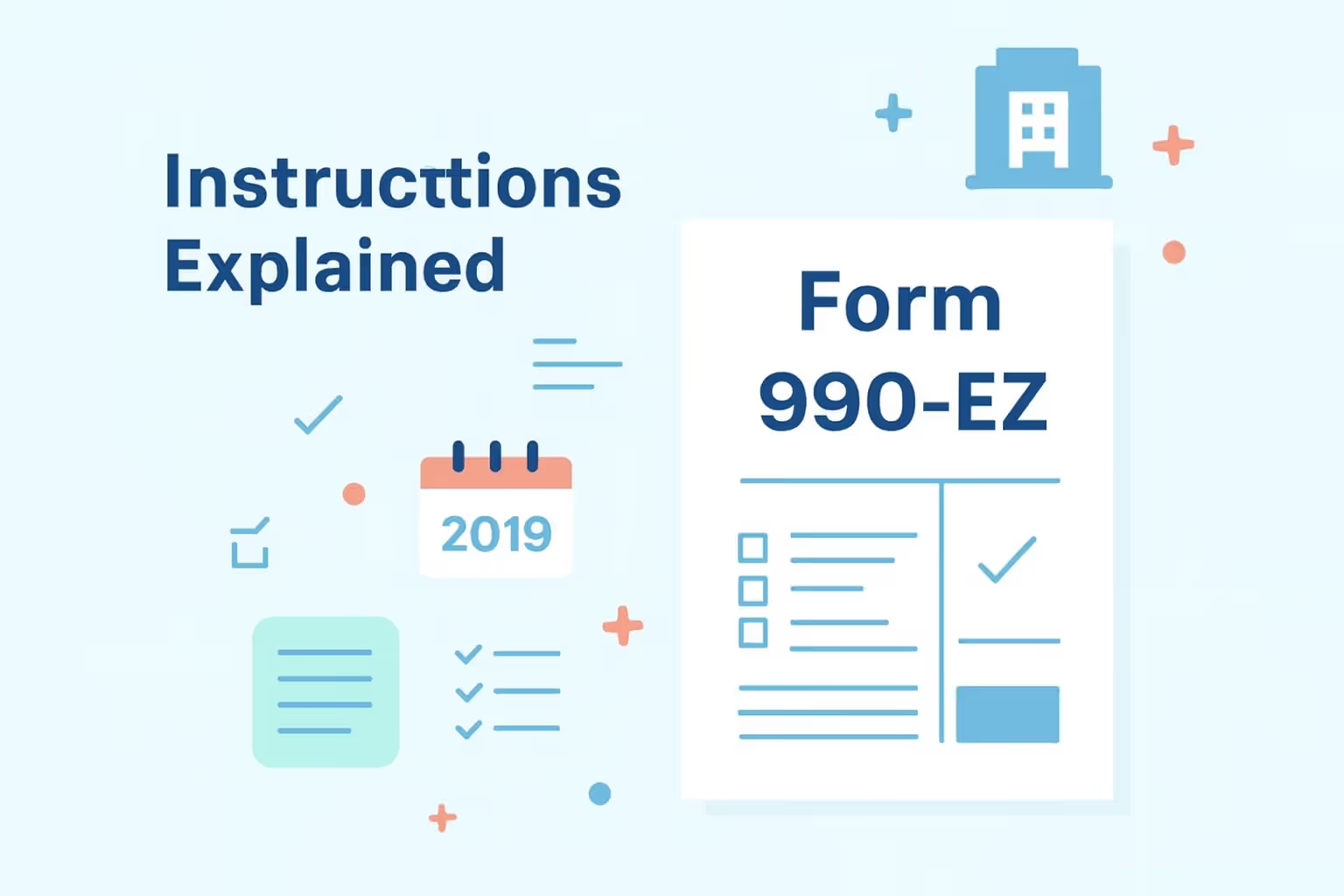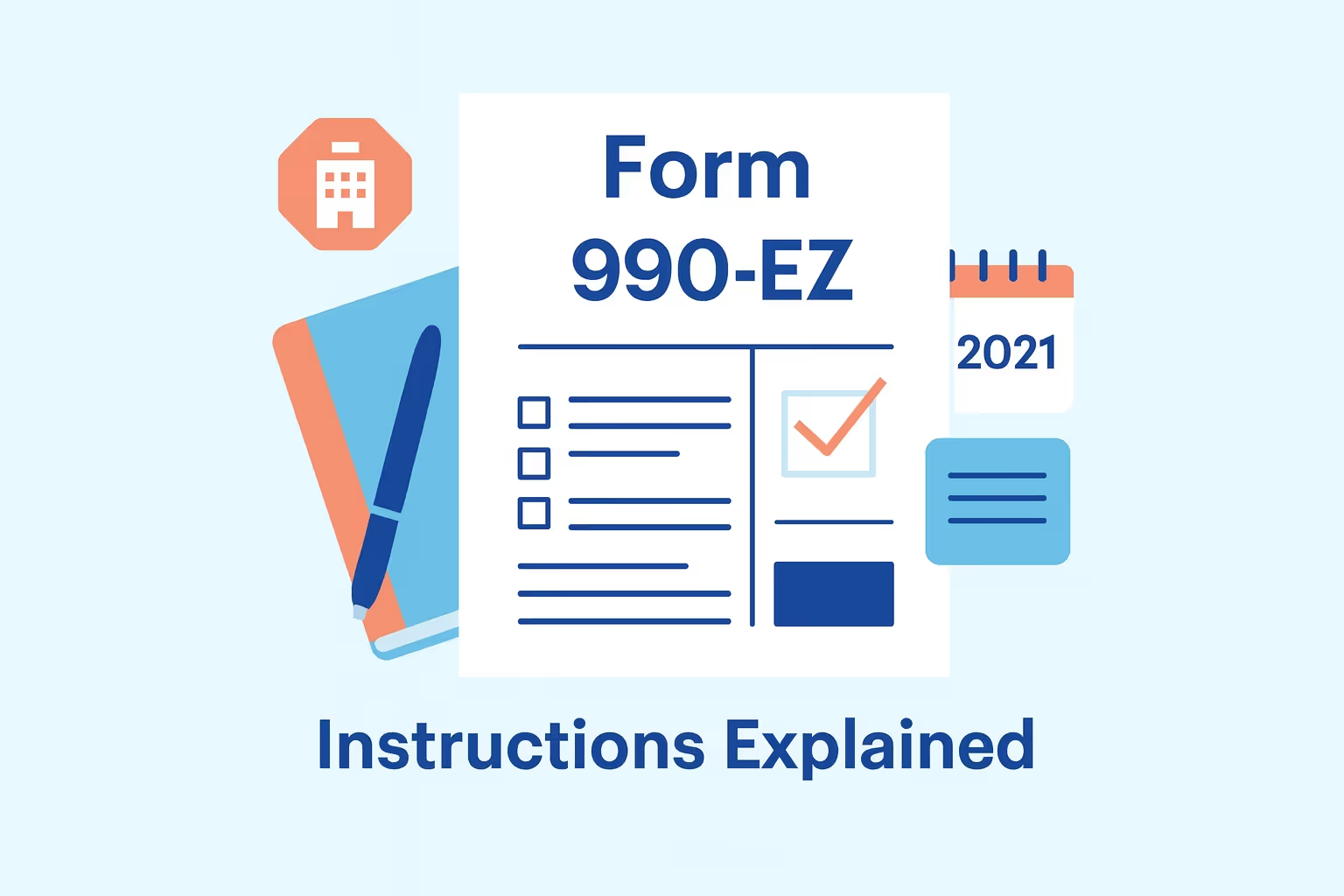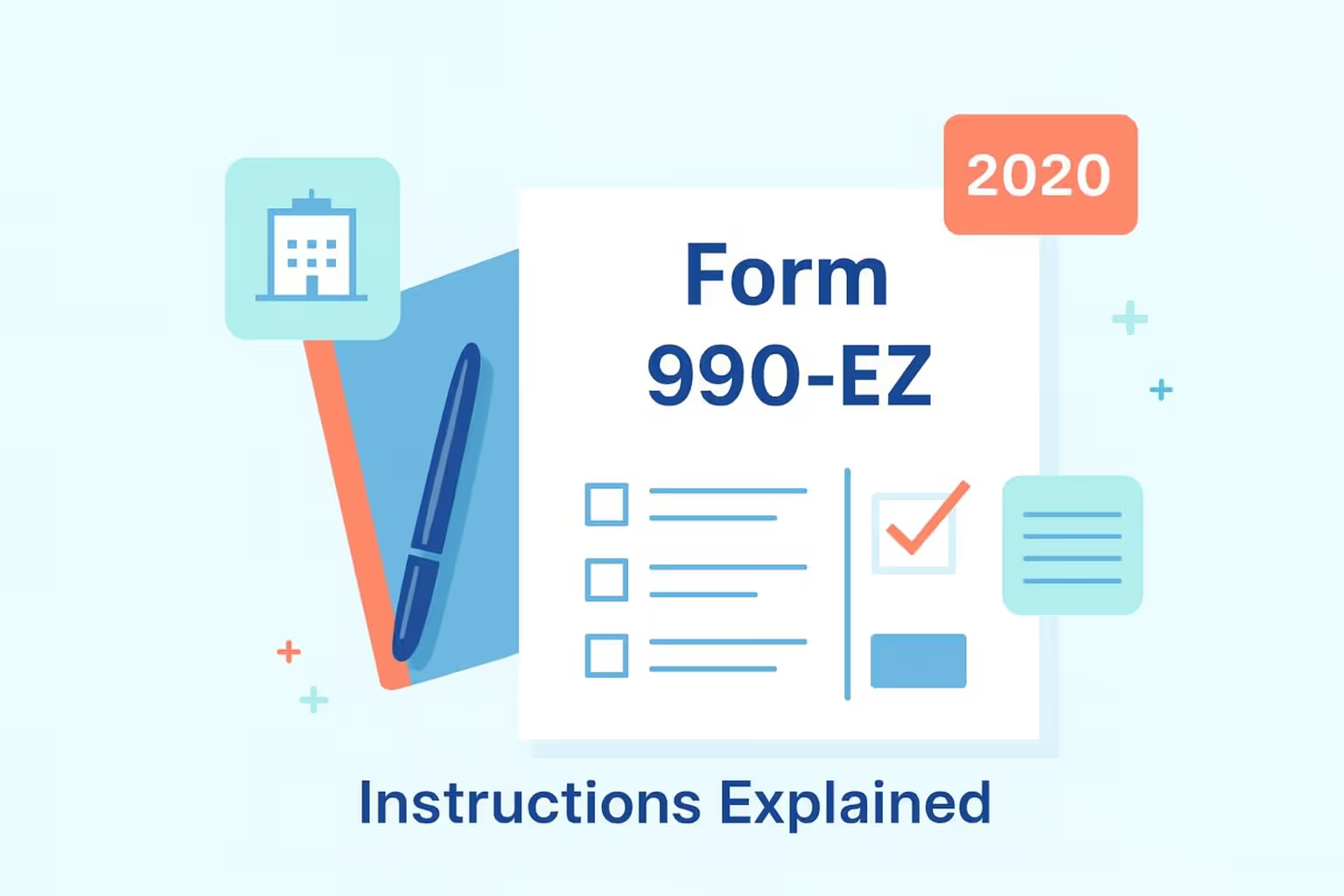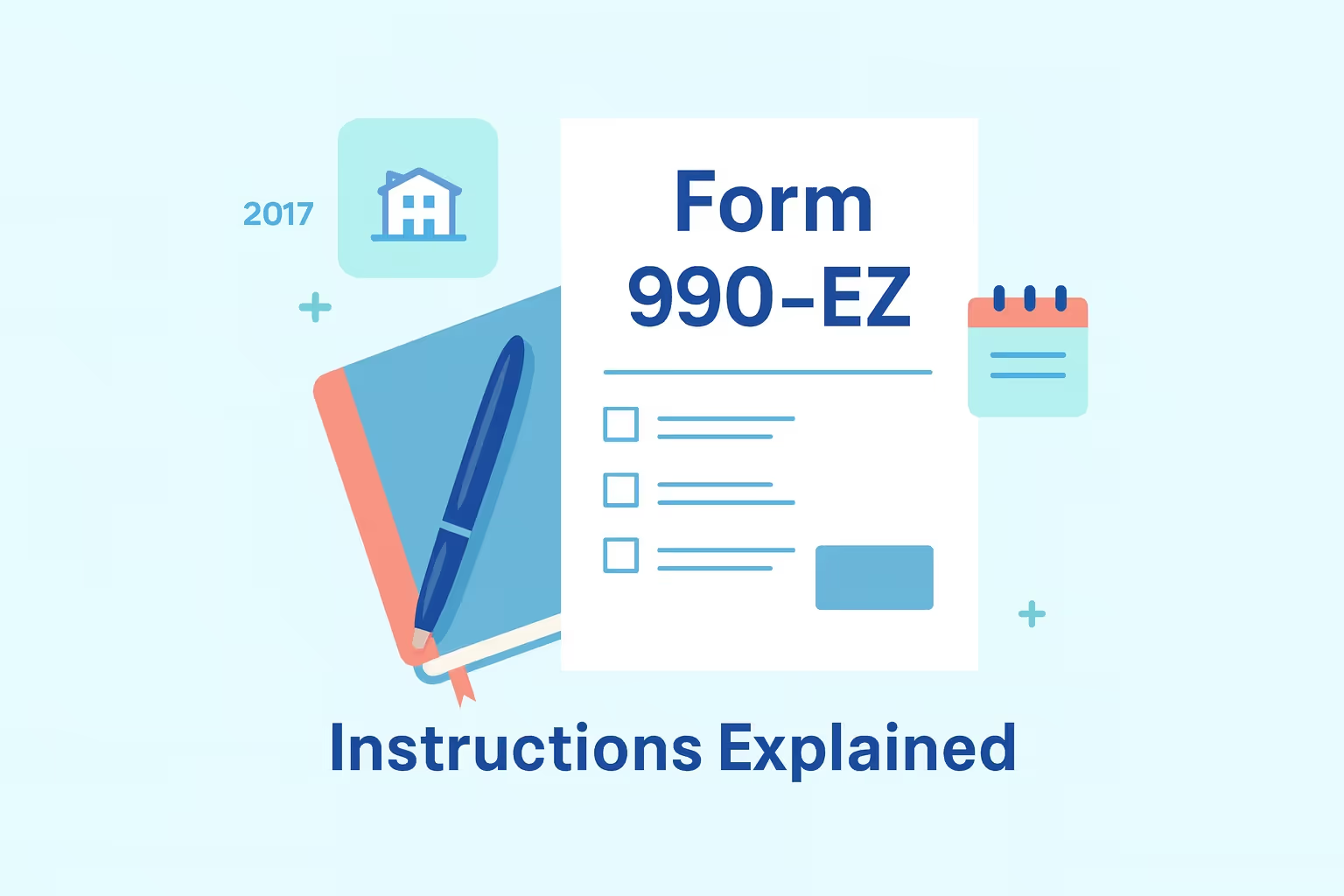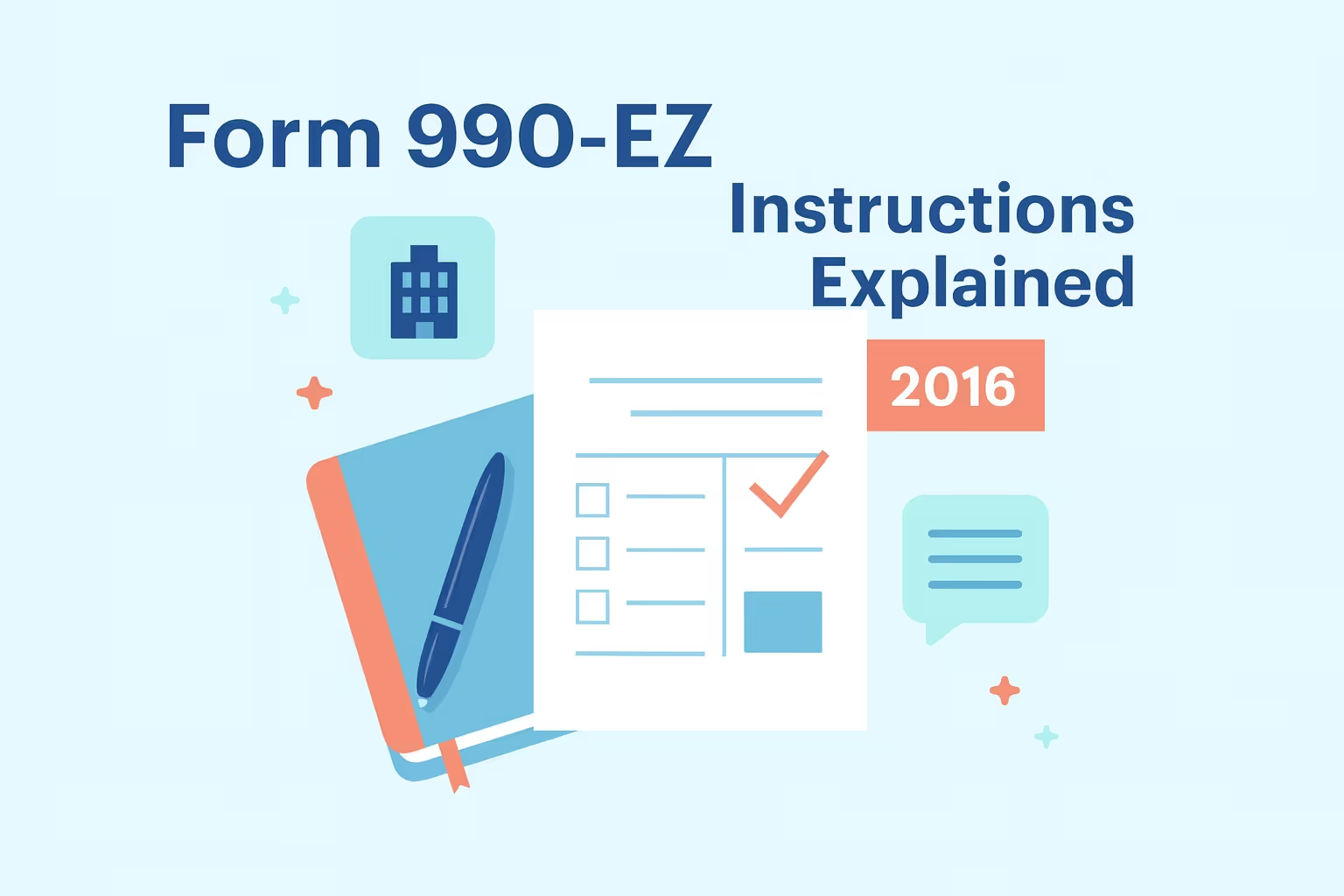Form 990-EZ 2013 Instructions for Tax-Exempt Groups
Filing accurate nonprofit tax returns is an essential responsibility of exempt organizations recognized under federal tax law. Form 990-EZ is a simplified tax filing option for small organizations that meet IRS thresholds for gross receipts and total assets. It allows charities, trusts, and associations to report key financial activities, ensuring transparency and compliance with federal income tax regulations. This shorter version of the return provides a practical way for qualifying groups to clearly document their resources and operations.
Organizations use Form 990-EZ to summarize their contributions, grants, and donations received throughout the tax year. This filing demonstrates how funds are allocated to support public education, mission-driven programs, and community initiatives. It also informs the IRS and the public about how nonprofits utilize government recognition of tax exemption to serve their communities. Transparent reporting fosters trust among donors, beneficiaries, and regulators, while also helping to maintain long-term eligibility for tax-exempt status.
Each section of Form 990-EZ is designed to capture detailed information about organizational structure, business activities, and program outcomes. Understanding the form’s purpose improves accuracy and reduces filing errors. To ensure accurate line references, review the IRS Form 990-EZ (2013) overview, which contains the approved version used for that tax year.
Understanding IRS Form 990 and 990-EZ
The IRS requires tax-exempt organizations to file annual returns that detail their financial activity and operational structure. These nonprofit tax returns help demonstrate compliance with federal income tax requirements and promote transparency for donors and regulators. Smaller entities may use Form 990-EZ, while larger organizations submit the full version to report comprehensive activities.
Definition and Purpose
- Form 990 is a comprehensive filing for large nonprofits with significant gross receipts or total assets. It outlines revenue, expenses, governance, and programs supporting exempt status.
- Form 990-EZ is a simplified filing option for small organizations with gross receipts of $200,000 or less and total assets of $500,000 or less. It eases the reporting process while maintaining accountability.
- Both forms allow organizations to confirm continued eligibility as exempt entities under federal law.
Eligibility Thresholds
- Organizations with annual gross receipts of $200,000 or less are eligible to file Form 990-EZ.
- Entities exceeding revenue or asset thresholds must complete the full form.
- Churches, government units, and private foundations follow separate filing requirements.
Who Must File
- Nonprofits, including charities, trusts, associations, and educational institutions, are required to file an annual return with the IRS.
- Private foundations submit Form 990-PF to document grants and related distributions.
- Churches and specific state government programs are generally exempt from filing tax returns.
Alternative Filings
- Groups with gross receipts typically below $50,000 may file Form 990-N, also known as the e-Postcard.
- Newly formed organizations complete an initial return for their first operational tax year.
- Entities that close operations must check the final return box before submission.
Form 990 and Form 990-EZ strengthen public trust and show how contributions support community benefit programs. Both filings verify that organizations use resources responsibly and maintain compliance. The IRS Instructions for Form 990-EZ (2013) provide comprehensive guidance to help organizations complete each section accurately.
Filing Requirements for Tax-Exempt Status
Organizations recognized as tax-exempt must meet specific filing requirements to maintain their status under federal income tax law. The IRS uses these filings to verify that entities operate within their approved missions and manage resources responsibly. Understanding eligibility criteria, exemptions, and timelines helps nonprofits file accurate reports each tax year.
Who Must File Form 990-EZ
Organizations with annual gross receipts under $200,000 and total assets under $500,000 qualify to file Form 990-EZ. This option applies to many charities, associations, and trusts that manage limited budgets but still engage in community-focused programs. Filing the short form ensures smaller groups remain compliant while avoiding the complexity of a full return.
Nonprofits using this form must clearly disclose their revenue, expenses, and program accomplishments. Each section reflects the organization’s commitment to transparency, allowing the IRS to confirm that tax benefits align with public service objectives. Completing all lines accurately and signing the return verifies that officers and trustees accept responsibility for the report.
Who Should Not File Form 990-EZ
Private foundations are required to file Form 990-PF because their operations differ significantly from those of public charities. Foundations often manage endowments, grants, and financial assistance programs that require separate reporting standards. Filing the correct form ensures these entities demonstrate proper stewardship of donor funds.
Churches, integrated auxiliaries, and certain religious institutions are generally exempt from filing federal tax returns as nonprofit organizations. State government entities, including universities and public schools, may also be exempt from the federal filing requirement. Organizations uncertain about their status should consult qualified tax professionals or refer to the IRS eligibility guidelines.
Employer Identification Number and Reporting Period
Every exempt organization must have an Employer Identification Number before submitting a return. The EIN identifies the organization in all IRS communications and connects filings across multiple tax years. The address and Employer Identification Number listed on the return must match IRS records to prevent processing delays.
Organizations may follow either a calendar year or a fiscal year reporting period, depending on their operational structure. The standard due date is the 15th day of the fifth month after the close of the reporting year. Entities filing for the first time should mark the return as an initial filing, while groups ceasing operations should select the final return box.
Maintaining accurate records and understanding filing obligations helps exempt organizations preserve their tax-exempt status and fulfill their public accountability requirements. Each completed return demonstrates responsible management of resources and adherence to federal reporting standards.
Step-by-Step Guide to Completing Form 990-EZ
Preparing Form 990-EZ requires accuracy and organization across all reporting areas. A structured approach enables tax-exempt organizations to remain compliant, maintain transparency, and foster public trust and confidence. Follow these steps to complete each section correctly.
Step 1. Gather Essential Documents
Begin by assembling all records supporting your reported figures. Collect financial statements showing income, expenses, and assets for the whole tax year. Include bank reconciliations, grant letters, payroll reports, and receipts for operational costs to confirm accuracy.
Keep articles of incorporation, bylaws, and board minutes to verify governance. Confirm that the Employer Identification Number and mailing address match IRS records. Having complete documentation on hand speeds preparation and reduces errors.
Step 2. Complete the Header Section
The header defines your organization’s reporting structure. Enter the legal name, mailing address, and Employer Identification Number exactly as registered. Indicate whether the filing is initial, amended, or final.
Select the accounting method, either cash or accrual, and ensure the reporting period aligns with a calendar or fiscal year. Accurate header details allow the IRS to track returns consistently.
Step 3. Report Revenue and Contributions
Present all sources of revenue clearly to reflect financial transparency. Include contributions, grants, and membership dues that funded your charitable programs. Report program service revenue from contracts or educational activities that support your exempt purpose.
Disclose interest, dividends, or rent from investments, and list property sales with selling price and cost basis. Verify that total revenue matches internal financial records before submission.
Step 4. Record Expenses and Program Costs
Accurate expense reporting demonstrates sound management and accountability. Categorize each cost to show how resources support your mission:
- Personnel Costs: Report salaries, wages, and employee benefits.
- Professional Fees: Include payments to attorneys, accountants, and independent contractors.
- Occupancy: Record rent, utilities, and maintenance expenses.
- Program Services: Detail spending for materials, outreach, and events.
- Administrative Expenses: Capture printing, postage, and insurance costs.
Verify totals against ledgers for consistency. Review each category carefully before finalizing entries. Confirm all expenses align with the organization’s approved budget and reporting standards.
Step 5. Prepare the Balance Sheet
List all assets, including cash, savings, investments, and property. Report liabilities such as loans and payables, then calculate net assets by subtracting liabilities from assets. Ensure the beginning balances match the figures from the previous year’s return. Reconcile discrepancies before filing to confirm financial accuracy.
Step 6. Describe Program Service Accomplishments
Summarize how your organization fulfilled its tax-exempt purpose. Highlight major programs, outcomes, and measurable results, such as the number of participants served or grants awarded. Connect each activity to your mission and describe community benefits. Clear, quantitative reporting builds credibility and demonstrates impact.
Step 7. Identify Officers, Directors, and Key Employees
List all officers, directors, trustees, and key employees active during the year. Include titles, average weekly hours, and compensation verified by payroll records. Accurate reporting of leadership details promotes transparency and reinforces strong governance.
Step 8. Review, Sign, and File
Review all entries, schedules, and attachments for completeness. The authorized officer must sign and date the return to certify accuracy. Filing electronically speeds up the processing and confirmation process. Retain a signed copy for records and share with the board for oversight.
A thorough review ensures compliance and protects your organization’s exempt status. Careful attention at each stage reduces risk and prevents errors. Accurate preparation fosters trust, enhances accountability, and supports ongoing organizational success.
Additional Information and Schedules
Form 990-EZ may require supplemental schedules that provide additional details about a nonprofit’s operations, funding, and compliance. These attachments allow tax-exempt organizations to explain complex financial activities, disclose relationships, and demonstrate public accountability. Including all required schedules ensures the return accurately reflects the organization’s mission and structure.
Each schedule serves a specific reporting purpose. Organizations must review filing thresholds carefully to determine which schedules apply. Attaching only the required forms promotes clarity and efficient processing.
- Schedule A – Public Charity Status and Public Support: This schedule is mandatory for all section 501(c)(3) organizations and section 4947(a)(1) nonexempt charitable trusts. It documents public support tests and determines whether the filer qualifies as a public charity or private foundation.
- Schedule B – Schedule of Contributors: This form is required when any single contributor donates more than $5,000 during the tax year. It lists donor names, addresses, and contribution totals, though donor identities are generally not subject to public disclosure.
- Schedule C – Political Campaign and Lobbying Activities: Organizations engaged in political or legislative advocacy must complete this schedule to describe campaign expenditures and lobbying efforts.
- Schedule G – Supplemental Information Regarding Fundraising or Gaming: Filers that conduct fundraising events or gaming activities with gross receipts exceeding $15,000 must disclose revenue, expenses, and professional fundraising costs.
- Schedule L – Transactions with Interested Persons: This form identifies financial transactions or relationships between the organization and insiders, including officers, directors, or key employees. Reporting these details demonstrates transparency and adherence to conflict-of-interest standards.
- Schedule O – Supplemental Information: Organizations use this schedule to explain complex entries, describe significant changes, or provide additional details that do not fit within the main form’s structure.
Each attachment should be labeled correctly and listed in the order specified in IRS guidelines. Consistent formatting ensures that reviewers can locate all disclosures quickly and confirm compliance. Proper documentation also supports public confidence in the organization’s stewardship of charitable resources.
Organizations preparing their returns for tax year 2013 can review the IRS Prior Year Forms and Instructions to download the official schedules and learn their specific filing thresholds. This resource provides access to prior-year materials and ensures that forms are aligned with the correct reporting period.
Including accurate and complete schedules strengthens the organization’s annual filing and reflects a commitment to ethical reporting. Each attachment enhances clarity, promotes accountability, and safeguards the organization’s tax-exempt status.
Public Access and Transparency
Transparency is a cornerstone of responsible nonprofit management and a key factor in maintaining public trust. Tax-exempt organizations that file Form 990-EZ must ensure their returns are accessible and accurate, allowing the public to evaluate how funds are managed. Providing open access to these filings helps strengthen credibility and reinforces accountability to donors and the community.
- Public Record: Form 990-EZ is a public document and must be made available for inspection upon request. Members of the public can review the filing to see how the organization generates revenue and allocates resources. Accessibility supports oversight and encourages ethical stewardship.
- Confidential Information: Sensitive personal data must be removed before any public release. Organizations should ensure that Social Security numbers, personal addresses, and financial account details do not appear on copies. Proper redaction safeguards privacy and reduces the risk of identity theft.
- Inspection Requirements: Nonprofits must provide access to their three most recent Form 990-EZ filings. They may fulfill this obligation by providing physical copies or directing individuals to an online source where the filings are available. Meeting disclosure standards satisfies federal transparency obligations.
- Record Retention: Organizations must retain copies of their filings and supporting documentation for a minimum of three years after the submission date. Maintaining accurate records ensures they can respond to inquiries from the public or the IRS. Secure storage preserves the organization’s institutional history and supports continuity.
- Transparency as a Governance Standard: Open access to financial and operational information demonstrates a commitment to integrity and transparency. Public disclosure of leadership, programs, and expenditures strengthens confidence among donors, beneficiaries, and regulatory agencies. Consistent transparency reinforces compliance and fosters long-term trust.
By adhering to clear disclosure and retention practices, nonprofits display accountability and uphold high ethical standards. Public transparency ensures continued confidence in the organization’s mission and financial stewardship.
Compliance, Penalties, and Audit Readiness
Maintaining compliance with IRS reporting standards is an essential responsibility for all tax-exempt organizations. Proper filing of Form 990-EZ safeguards an organization’s standing and protects its exemption from federal income tax. Missing filing requirements or deadlines can result in financial penalties and increased IRS scrutiny.
Nonprofits must verify every reported figure and ensure their filings align with financial records. Consistent accuracy demonstrates accountability and supports trust among donors, grantors, and government agencies. A well-documented compliance process also strengthens audit readiness and reinforces the organization’s reputation for transparency.
Common Compliance Obligations:
- Timely Filing: Organizations must file Form 990-EZ by the 15th day of the fifth month after the close of their fiscal year. Filing on time prevents automatic late fees and protects tax-exempt status.
- Accurate Information: Every section must reflect the organization’s actual financial activity, including gross receipts, total assets, and contributions. Misstated or omitted data may trigger an IRS review or inquiry.
- Schedule Attachments: All required schedules, such as those detailing grants or transactions with interested persons, must be accurately completed and attached to the return. Missing schedules often delay processing or invite compliance notices.
- Board Oversight: Leadership should review filings before submission. Having trustees or officers verify accuracy helps confirm the integrity of the organization’s financial reporting.
Organizations that fail to meet compliance obligations may face significant penalties. These can include daily fines based on gross receipts, suspension of federal tax benefits, or potential revocation of exemption status. Consistent errors or unfiled returns across multiple years heighten the risk of examination.
Audit Preparation Practices:
- Recordkeeping: Maintain complete documentation to support all reported revenue, expenses, and assets. Detailed records allow quick verification of reported amounts during an audit.
- Internal Controls: Establish policies that govern the approval of expenditures, account reconciliation, and the segregation of duties to ensure effective financial management. Strong controls reduce the risk of mismanagement.
- Annual Reviews: Conduct internal or third-party reviews of financial statements. Regular evaluations detect discrepancies and promote timely correction.
- Communication: Ensure all officers and key employees understand their roles in maintaining compliance. Transparent coordination strengthens the organization’s ability to respond to inquiries.
Meeting all IRS reporting expectations reflects professionalism and dedication to lawful operation. Nonprofits that maintain organized records and adhere to deadlines can navigate audits with confidence, thereby preserving public trust in their mission and ensuring its effectiveness.
Common Mistakes and Practical Tips
Completing Form 990-EZ requires careful attention to detail. Many tax-exempt organizations make minor but costly errors that can lead to delayed processing, compliance notices, or penalties. Identifying these common mistakes early helps ensure accuracy and strengthens trust with the IRS.
- Incorrect Filing Eligibility: Organizations sometimes submit Form 990-EZ without verifying their eligibility to do so. Only organizations with gross receipts of less than $200,000 and total assets of less than $500,000 can file this form. Using the incorrect form type may result in rejection or penalties.
- Incomplete Header Details: Errors or omissions in the header can disrupt the record matching process. Verify that the Employer Identification Number, organization name, and tax year match IRS records. Indicate clearly whether the return is an initial, amended, or final filing.
- Mathematical and Reporting Errors: Miscalculations often cause mismatched totals. Check that total revenue equals the sum of all income lines. Confirm that expenses and assets align with financial statements before submission.
- Omitted Schedules and Attachments: Missing schedules frequently result in compliance letters. Include every required schedule that reports grants, fundraising, or related organizations. Label each attachment with the organization’s name and Employer Identification Number.
- Inconsistent Expense Reporting: Misclassifying or duplicating costs can lead to confusion. Ensure payroll, occupancy, and program expenses are accurately reflected in accounting records to prevent discrepancies. Consistency supports clear and transparent financial reporting.
- Late Submissions: Missing deadlines can trigger daily penalties based on gross receipts. File by the 15th day of the fifth month following the close of the fiscal year. Submit Form 8868 before the due date if you need more time.
- Weak Recordkeeping Practices: Incomplete documentation increases the risk of non-compliance. Maintain receipts, grant records, and bank statements for at least three years. Organize records to make audits and reviews more efficient and effective.
By addressing these common issues, nonprofits can improve accuracy and enhance their reputation for compliance. Reliable recordkeeping and timely filing demonstrate accountability and help sustain public confidence. Consistent attention to detail ensures smoother reporting and long-term organizational stability.
Frequently Asked Questions
What is the purpose of Form 990-EZ for exempt organizations?
Form 990-EZ serves as a simplified annual return for exempt organizations that meet size-based eligibility requirements. It allows small and mid-size nonprofits to report their financial activities, leadership structure, and mission-driven outcomes to the IRS. Filing this form helps organizations remain compliant under the Internal Revenue Code and maintain public transparency. It also enables the IRS to monitor operations and confirm continued qualification for federal tax exemption.
Can Form 990-EZ be filed electronically, and what are the benefits?
Yes, Form 990-EZ can be filed electronically using IRS-approved e-file providers or authorized software. Electronic filing offers faster confirmation, fewer errors, and improved accuracy compared to paper submission. It also ensures timely delivery and accurate recordkeeping. Many organizations prefer e-filing because it streamlines data entry and reduces administrative burden, making it easier to meet annual reporting requirements and maintain compliance with federal standards for nonprofit operations.
Are there exceptions to filing Form 990-EZ?
Specific organizations qualify for exceptions and are exempt from filing Form 990-EZ. These include churches, integrated auxiliaries, and conventions or associations of churches. Additionally, organizations with gross receipts typically under $50,000 may file the electronic Form 990-N (e-Postcard) instead. Private foundations must file Form 990-PF. Reviewing eligibility ensures that the correct form is submitted and prevents errors that could delay processing or result in correspondence from the IRS regarding compliance.
How do exempt organizations report grants and contributions?
Exempt organizations must accurately report all grants, contributions, and similar receipts on Form 990-EZ. These figures illustrate how the organization supports its mission and engages with donors and funding partners. Each grant should clearly reflect both its source and purpose, especially when linked to specific programs or outreach initiatives. Transparent reporting helps clarify how donated funds support charitable goals and provides a clear financial picture for the IRS, donors, and stakeholders evaluating an organization's performance.
What happens if an exempt organization fails to act on filing deadlines?
Missing a filing deadline can result in daily financial penalties and may lead to the revocation of tax-exempt status. The IRS expects consistent compliance from all registered organizations. If a return is filed more than three years late, the organization may automatically lose its exemption. Setting calendar reminders and using electronic filing options help ensure timely submission and ongoing compliance with the Internal Revenue Code and nonprofit reporting regulations.
How can organizations explore filing support or professional guidance?
Organizations can explore professional tax support or nonprofit compliance specialists to improve filing accuracy. Consulting experts familiar with IRS requirements helps ensure each section is completed correctly. This proactive approach allows organizations to address unique circumstances and remain aligned with federal regulations. Reliable guidance strengthens audit readiness, enhances data accuracy, and reassures stakeholders that filings are managed responsibly in accordance with current tax laws and regulations.
Why is accurate reporting integral to nonprofit compliance?
Accurate reporting is crucial for maintaining an organization’s reputation, ensuring transparency, and maintaining a good standing with the IRS. It demonstrates accountability to the public and donors while reinforcing adherence to federal tax requirements. Each section of Form 990-EZ should reflect genuine financial activity, governance, and mission outcomes. Consistent accuracy reduces audit risk, improves trust among funding partners, and ensures the organization continues meeting its obligations under federal exempt organization regulations.
















